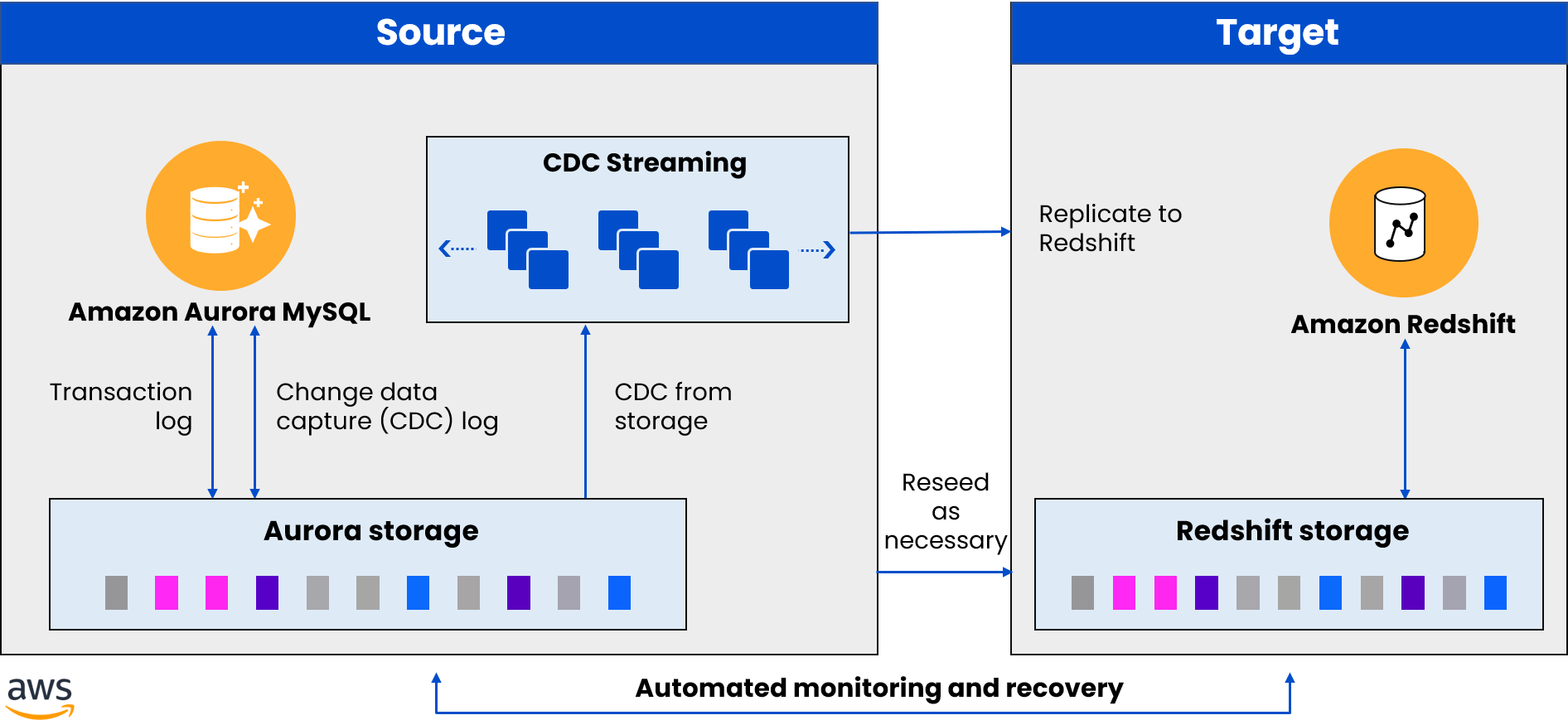Transforming Data Management: Unleashing the Power of Zero-ETL in AWS
Publish Date: February 16, 2024Meet YASH at the AWS booth at GITEX 2024 | Date: 14-18 October 2024 | World Trade Centre, Dubai (Booth no. H8 A20) Click here to know more!
Introducing AWS Zero ETL: Simplifying Data Integration
Given the dominance of Amazon Web Services in the cloud marketplace, AWS CEO Adam Selipsky touted a Zero ETL (Extract, Transform, Load) future, transforming how data is managed and processed.
Zero-ETL represents a paradigm shift in the world of data integration and analytics. Zero-ETL is a data pipeline method that eliminates extraction, transformation, and loading processes in ETL and ETL tools. Data should be stored and analyzed with the source system’s original format without any transformation or movement. Zero-ETL can also enable querying across data silos without the need for data movement.
Traditional ETL processes are time-consuming and complex to develop, maintain, and scale. AWS noted that some companies support entire teams to facilitate this process. Additionally, it can take days before data is ready for analysis, and intermittent data transfer errors can delay access to time-sensitive insights even further, leading to missed business opportunities.
Supported Zero-ETL integrations with AWS
- Aurora MySQL to Amazon Redshift
- Aurora PostgreSQL to Amazon Redshift
- RDS MySQL to Amazon Redshift
- DynamoDB to Amazon Redshift
- Amazon S3 with Amazon OpenSearch Service
- Amazon DynamoDB with Amazon OpenSearch Service
Architecture and Workflow
With Amazon Redshift Streaming Ingestion, organizations can configure Amazon Redshift to directly ingest high-throughput streaming data from Amazon Managed Streaming for Apache Kafka (Amazon MSK) or Amazon Kinesis Data Streams and make it available for near-real-time analytics in just a few seconds. They can connect to multiple data streams and pull data directly into Amazon Redshift without staging it in Amazon Simple Storage Service (Amazon S3). After running analytics, the insights can be made available broadly across the organization with Amazon QuickSight, a cloud-native, serverless business intelligence service. QuickSight makes it incredibly simple and intuitive to get answers with Amazon QuickSight Q. It allows users to ask business questions about their data in natural language and receive answers quickly through data visualizations.
Another example of AWS’s investment in zero-ETL is providing the ability to query various data sources without worrying about data movement. Using federated queries in Amazon Redshift and Amazon Athena, organizations can run queries across data stored in their operational databases, data warehouses, and data lakes to create insights across multiple data sources without data movement. Data analysts and engineers can use familiar SQL commands to join data across several data sources for quick analysis and store the results in Amazon S3 for subsequent use. This provides a flexible way to ingest data while avoiding complex ETL pipelines.


High-level working on Aurora MySQL zero-ETL integration with Amazon Redshift (Source. aws.amazon.com)
Benefits of Zero-ETL
Zero ETL (Extract, Transform, Load) refers to a data integration approach where data is queried directly in its native format, eliminating the need for traditional ETL processes. Here are some benefits of Zero ETL:
- Enhanced data quality & accessibility: Reduces error risks during extraction/loading, making data from diverse sources readily available for analysis.
- Streamlined data analytics: Eliminates time-consuming transformations, accelerates analysis, and enables faster decisions.
- Greater flexibility: Adapts quickly to changing data structures and formats, handling diverse sources and types effortlessly.
- Increased productivity: Frees up data professionals from manual transformations, allowing them to focus on high-value tasks like analysis and interpretation.
- Real-time Insights: With Zero ETL, data can be queried in real-time, allowing organizations to make decisions based on the most up-to-date information.
- Cost Savings: Traditional ETL processes can be resource-intensive in time and money. Organizations can realize cost savings by eliminating the need for ETL tools, infrastructure, and maintenance.
- Faster Time-to-Value: With Zero ETL, organizations can derive insights from their data more quickly and efficiently, leading to a faster time-to-value for analytics and business intelligence initiatives.
- Improved Data Governance: Since data is queried in its native format, there is less risk of data transformation errors or discrepancies. This can lead to improved data governance and accuracy.
Key Use Cases
- Real-time Analytics
- Federated Querying
- Instant Replication
- Ad-hoc Data Exploration
- Data Lakes and Data Warehouses – Data Lakehouses
- Complex Data Transformations
Best Practices
Implementing AWS Zero ETL involves leveraging various features and best practices to ensure efficient data processing and analytics. Here are some best practices for implementing AWS Zero ETL:
Utilize Zero-ETL Integrations – Take advantage of zero-ETL integrations, such as the integration between Amazon Aurora and Amazon Redshift, to enable near real-time analytics and machine learning using Amazon Redshift on transactional data from Aurora.
Leverage Streaming Ingestion and Federated Querying – Utilize features within AWS services that support the Zero-ETL approach, such as Amazon Redshift Streaming Ingestion directly from Kinesis and MSK to Redshift, and Federated Query in Amazon Redshift and Amazon Athena, to analyze data where it sits without the need for traditional ETL processes.
Centralized Data Lake and Purpose-Built Analytics Services – Establish a centralized data lake and a collection of purpose-built analytics services to access data wherever it resides, ensuring unified data access, security, and governance.
Efficient Management of Zero-ETL Integrations – Ensure efficient management of zero-ETL integrations using the AWS Management Console, AWS CLI, or the RDS API to create, manage, and delete integrations.
Instant Replication and Change Data Capture (CDC) Techniques – Leverage instant replication capabilities of Zero-ETL, which uses change data capture (CDC) techniques to instantly duplicate data from transactional databases to data warehouses, providing a seamless experience for users and analysts
Challenges and Considerations
Customers across industries today want to increase revenue and customer engagement by implementing near-real-time analytics using cases like personalization strategies, fraud detection, inventory monitoring, and many more. There are two broad approaches to analyzing operational data for these use cases:
- Analyze the data in place in the operational database (e.g., read replicas, federated query, analytics accelerators)
- Move the data to a data store optimized for running analytical queries, such as a data warehouse.
The zero-ETL integration is focused on simplifying the latter approach.
In a nutshell, zero-ETL is an advanced data management approach that helps businesses streamline their data processes, improve data accessibility and quality, and enhance the speed and flexibility of data analytics. By leveraging modern data platforms, data lake architectures, and real-time data integration, zero-ETL ensures that data is always ready for analysis, enabling quicker insights and more informed decision-making.
Why Choose YASH Technologies as your Reliable AWS Partner?
YASH has a proven track record in AWS implementation and managed services. We simplify migrations and transformations, reducing risks and expenses. Our dynamic approach optimizes the AWS ecosystem, delivering robust and precise solutions for industry-specific needs. Our specialized team of experts in AWS CoE is committed to enhancing the AWS experience, providing innovation, and ensuring smooth integration and management, even within intricate global IT landscapes. To learn more about our AWS capabilities, please visit our AWS webpage.
















